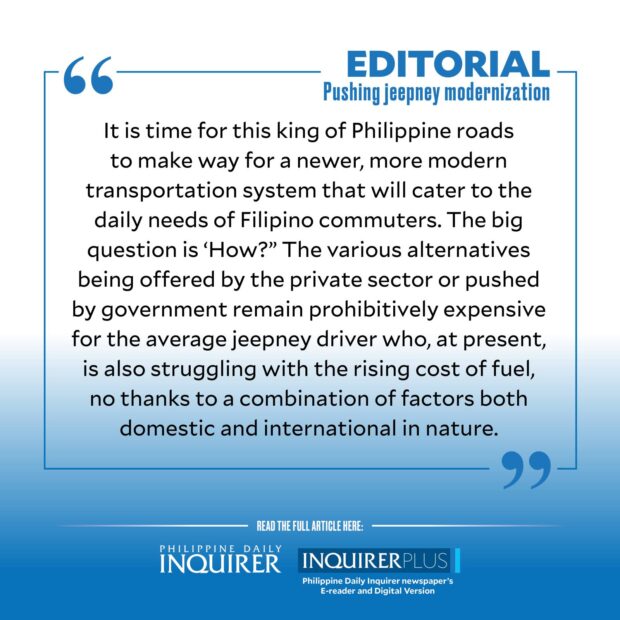
And one of these transportation systems that is long overdue for a major upgrade is the jeepney, one of the icons of Filipino identity that has, over the years, also been called “the king of the road.”
Indeed, the jeepney—basically the design of a World War II military jeep, expanded into a minibus where passengers ride facing each other on two long benches—has long reigned supreme in the country ferrying commuters on paved highways in the city and unpaved dirt roads in rural areas.
But just like some ruling monarchs, this king of the road is now way past its prime and is now in danger of overstaying its welcome among its subject commuters.
With most jeepneys still powered by smoke-belching rebuilt and reconditioned diesel engines (bought as surplus parts from Japan), they pose a threat to our increasingly fragile environment no thanks to the toxic fumes they emit, especially while idling in heavy traffic. The smog that enveloped Metro Manila last month, which led to the cancellation of classes, was traced to emissions from the heavy volume of vehicles trapped in the infamous Metro traffic gridlocks.
Meanwhile, most of those jeepney units lucky enough to run on low-density routes are noncompliant with modern safety standards for vehicles, as passengers sitting on long benches are not secured by seatbelts. And forget about airbags that inflate automatically during collisions, or crumple zones that help absorb the impacts of vehicular crashes. None of these are present in jeepneys whose basic designs have remained unchanged since they were introduced to Philippine roads in the late 1940s.
It is time for this king of Philippine roads to make way for a newer, more modern transportation system that will cater to the daily needs of Filipino commuters.
The big question is “How?”
The various alternatives being offered by the private sector or pushed by government remain prohibitively expensive for the average jeepney driver who, at present, is also struggling with the rising cost of fuel, no thanks to a combination of factors both domestic and international in nature.
Modernization must come, and our policymakers should make it their priority to encourage the millions of operators around the country to shift to new vehicles that are more efficient, cleaner for the environment, and safer for passengers.
But the government’s preferred method of ramming change down the throats of the transportation sector is unlikely to work. In fact, government has been trying to push the jeepney industry to change for decades now, but progress has been slow and uneven.
What then should President Marcos do to finally modernize this sector that has long resisted change?
Since “pushing” recalcitrant jeepney operators toward modernization has, for the most part, failed, the administration should consider “pulling” them toward this goal by making owning and operating modernized jeepneys more attractive.
To do this, the government should consider expanding tax breaks for the manufacture and sale of jeepneys that conform with the desired definition of modernization, including having newer and cleaner engines that burn fuel more efficiently, those that use hybrid technology, or those that run purely on batteries. Instead of forcing jeepney operators to accept the expensive imported units, the government should support the local jeepney manufacturers’ shift to more environment-friendly iterations.
The government should also initiate a program using its various government financial institutions to offer loans at concessional rates for jeepney operators shifting to these modern vehicles.
Since their cost of operation is cheaper than current jeepneys, transport regulators should also consider imposing lower fare caps to encourage commuters to patronize modern jeepneys in lieu of older ones.
Finally, the government should redouble its efforts at expanding the country’s other mass transport modes, including trains, light rail systems, modern buses, and bus rapid transit systems, all of which will give Filipinos more alternatives to jeepneys. This competition is, in turn, what will spur the change-resistant jeepney sector to adapt to the preferences of modern commuters.
No doubt, the king of the road has served Filipino commuters well for almost eight decades now. But this king is old and tired and way past his prime. It is time for the jeepney to give way to a successor that can continue plying the country’s roads in safer and more efficient ways.